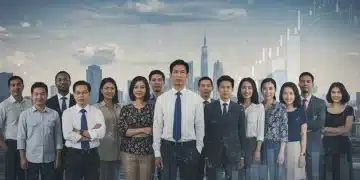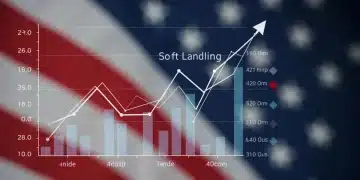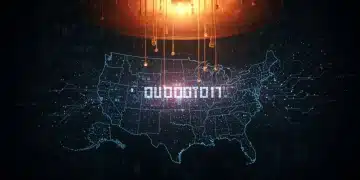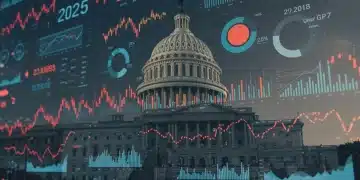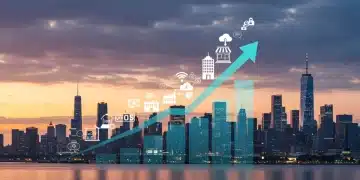Labor Shortage Reshaping US Economy: A 2025 Analysis
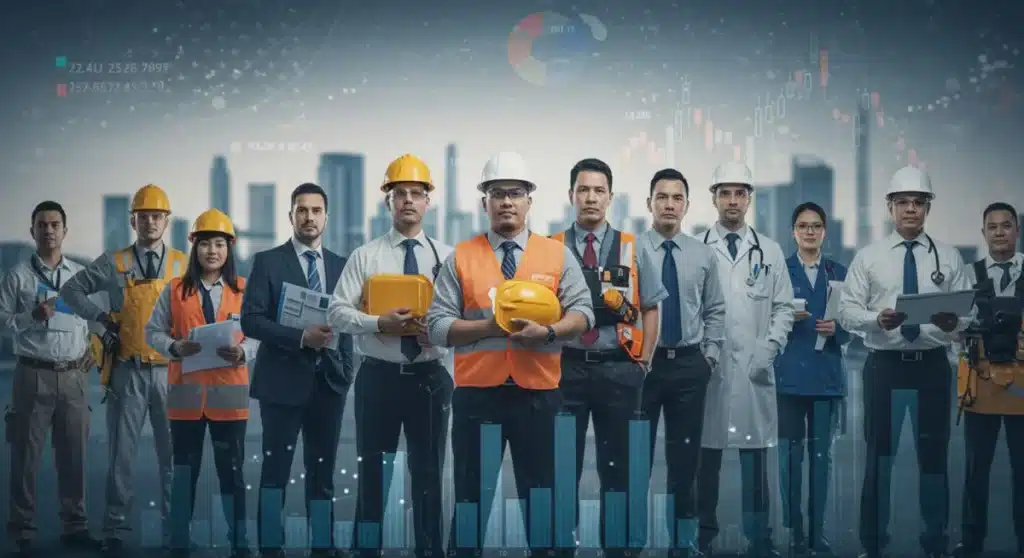
The current labor shortage is profoundly reshaping the US economy in 2025, driving significant changes in employment strategies, wage structures, and technological adoption across various sectors, demanding adaptive business models.
The landscape of employment in the United States is undergoing a seismic shift. As we navigate through 2025, the question of how the current labor shortage is reshaping the US economy: a 2025 analysis becomes increasingly vital for businesses, policymakers, and workers alike. This persistent scarcity of available talent isn’t just a temporary blip; it’s a fundamental force altering the very foundations of economic operation.
Understanding the Roots of the Labor Shortage
The current labor shortage isn’t a monolithic phenomenon but rather a complex interplay of various factors that have converged to create a challenging environment for employers across the United States. Delving into its origins requires looking beyond simple explanations and considering demographic shifts, evolving worker expectations, and the lingering effects of global events.
One significant driver is the demographic shift within the US population. The aging workforce, with baby boomers increasingly retiring, is creating a vacuum that younger generations are not filling at the same pace. This generational transition has profound implications for industries that traditionally relied on experienced workers.
Demographic Shifts and an Aging Workforce
The steady retirement of the baby boomer generation has been a long-anticipated demographic trend, yet its impact on the labor market has become acutely felt in recent years. This outflow of experienced workers, coupled with lower birth rates in subsequent generations, means there are simply fewer people entering the workforce to replace those leaving it.
- Retirement Wave: Millions of experienced workers have exited the workforce, taking with them decades of institutional knowledge and specialized skills.
- Declining Birth Rates: The rate at which new workers are entering the labor pool is insufficient to offset the retirement wave, exacerbating the supply-demand imbalance.
- Skill Gaps: The skills of retiring workers often don’t directly align with the demands of emerging industries, creating significant gaps that are difficult to fill quickly.
Beyond demographics, the pandemic acted as a catalyst, prompting many to re-evaluate their careers and work-life balance. This shift in priorities has led to a more discerning workforce, less willing to accept demanding conditions or stagnant wages, further contributing to the shortage. Understanding these foundational elements is crucial for comprehending how the current labor shortage is reshaping the US economy in 2025.
Wage Inflation and Compensation Trends
One of the most immediate and tangible effects of the labor shortage has been the upward pressure on wages. Businesses, desperate to attract and retain talent, are finding themselves in a bidding war, leading to significant shifts in compensation structures across various sectors. This isn’t just about minimum wage increases; it’s about a broader re-evaluation of worker value.
The competitive nature of the current job market means that employers are not only offering higher base salaries but also enhancing benefits packages and providing more attractive incentives. This trend is particularly pronounced in industries facing the most severe shortages, such as healthcare, technology, and hospitality.
The Impact on Business Operating Costs
While increased wages are beneficial for workers, they represent a substantial increase in operating costs for businesses. Companies are forced to absorb these higher expenses, which can lead to reduced profit margins or, more commonly, be passed on to consumers in the form of higher prices, contributing to inflationary pressures.
- Reduced Profit Margins: Businesses, especially small and medium-sized enterprises, struggle to absorb higher labor costs without impacting their bottom line.
- Consumer Price Increases: To maintain profitability, many companies are forced to raise prices for goods and services, contributing to overall inflation.
- Investment in Automation: Higher labor costs incentivize businesses to invest more heavily in automation and technology to reduce their reliance on human labor.
The ripple effect of wage inflation extends beyond individual companies, influencing national economic indicators and consumer spending patterns. As workers earn more, their purchasing power theoretically increases, but if inflation outpaces wage growth, real wages may stagnate or even decline. This dynamic is a critical aspect of how the current labor shortage is reshaping the US economy in 2025.
Automation and Technological Adoption Surge
In direct response to the persistent labor shortage, businesses across the US are accelerating their adoption of automation and advanced technologies. This isn’t merely a trend; it’s becoming a strategic imperative for survival and growth in an environment where human labor is scarce and expensive. From robotics in manufacturing to AI in customer service, technology is stepping in to fill the void.
The integration of these technologies is transforming workplaces, redefining job roles, and demanding new skill sets from the existing workforce. Companies are investing heavily in solutions that can perform repetitive tasks, improve efficiency, and even manage complex operations with minimal human intervention.
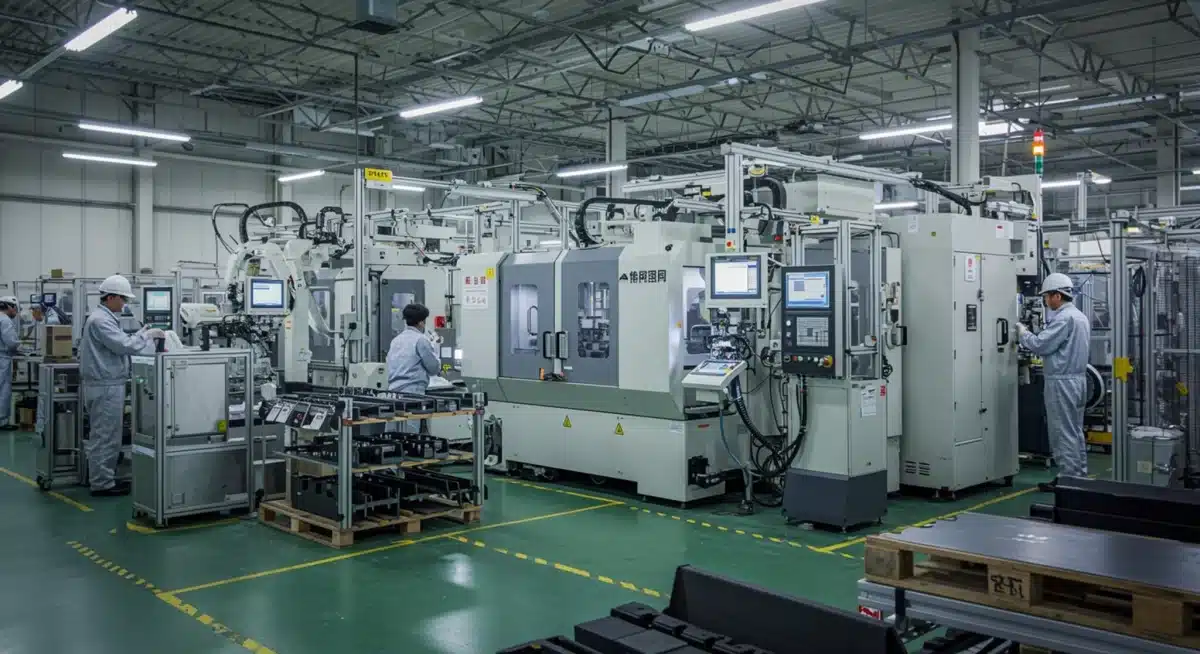
Robotics in Manufacturing and Logistics
Manufacturing and logistics sectors have been at the forefront of automation for decades, but the current labor shortage has dramatically sped up this process. Robots are now handling tasks that were once exclusively performed by humans, from assembly line operations to warehouse management.
This shift not only addresses labor gaps but also improves safety, consistency, and speed. However, it also raises questions about the future of human employment in these sectors and the need for retraining programs to equip workers with the skills to operate and maintain these new systems.
AI and Software Solutions in Services
The service industry, traditionally highly reliant on human interaction, is also seeing a significant increase in AI and software adoption. Chatbots are handling customer inquiries, AI-powered systems are streamlining administrative tasks, and advanced analytics are optimizing decision-making.
- Enhanced Customer Service: AI-driven chatbots and virtual assistants provide 24/7 support, reducing the need for human agents for routine queries.
- Streamlined Operations: Software solutions automate data entry, scheduling, and other administrative tasks, freeing up human employees for more complex work.
- Data-Driven Decisions: AI algorithms analyze vast amounts of data to inform business strategies, from inventory management to marketing campaigns.
The surge in automation and technological adoption is fundamentally altering the nature of work, creating demand for new skills while potentially displacing others. Businesses that successfully integrate these tools will gain a significant competitive advantage, further illustrating how the current labor shortage is reshaping the US economy in 2025.
Shifting Workforce Demands and Skill Development
The evolving economic landscape, driven by the labor shortage and technological advancements, is creating a significant shift in the skills demanded by employers. The traditional focus on manual or routine tasks is giving way to a greater emphasis on cognitive, technical, and interpersonal skills that complement automation rather than compete with it.
This transformation necessitates a proactive approach to skill development, both from individuals seeking employment and from organizations aiming to build a resilient workforce. Lifelong learning is no longer a buzzword; it’s a necessity for staying relevant in a rapidly changing job market.
The Rise of Soft Skills and Digital Literacy
While technical skills are undeniably important, the ability to collaborate, problem-solve, adapt, and communicate effectively—often referred to as soft skills—is becoming increasingly critical. As routine tasks are automated, human workers are expected to excel in areas that machines cannot replicate.
Simultaneously, digital literacy has become a foundational requirement across almost all industries. Workers need to be comfortable with various software applications, data analysis tools, and digital communication platforms to perform their jobs effectively.
- Critical Thinking: The ability to analyze complex situations and make informed decisions is highly valued.
- Adaptability: Workers must be able to learn new technologies and adjust to changing work environments quickly.
- Collaboration: Teamwork and effective communication are essential in increasingly interconnected workplaces.
- Digital Proficiency: Competency in using digital tools and understanding data is a baseline expectation.
Educational institutions and corporate training programs are adapting to these new demands, focusing on curricula that foster both technical expertise and essential soft skills. The success of the US economy in addressing the labor shortage hinges on its ability to effectively reskill and upskill its workforce, a key element in how the current labor shortage is reshaping the US economy in 2025.
Government and Corporate Responses to the Shortage
Recognizing the profound impact of the labor shortage, both government bodies and corporations are implementing a variety of strategies to mitigate its effects and foster a more robust labor market. These responses range from policy initiatives aimed at increasing labor participation to innovative corporate programs designed to attract and retain talent.
The effectiveness of these measures will largely determine the long-term health and competitiveness of the US economy. Collaboration between public and private sectors is becoming increasingly vital to address a challenge of this magnitude.

Policy Initiatives and Immigration Reforms
Governments are exploring various policy levers to alleviate the labor shortage. This includes discussions around immigration reform to allow more skilled workers into the country, as well as initiatives to support childcare and eldercare, which can enable more individuals to participate in the workforce.
Additionally, investments in vocational training and community college programs are aimed at creating clearer pathways to high-demand jobs, bridging the gap between available skills and industry needs.
Corporate Strategies for Talent Attraction and Retention
On the corporate front, companies are rethinking their entire approach to human resources. Beyond competitive wages, they are offering enhanced benefits, flexible work arrangements, and robust career development opportunities to stand out in a tight labor market.
- Flexible Work: Remote and hybrid work models have become standard offerings, providing employees with greater autonomy and work-life balance.
- Upskilling Programs: Companies are investing in internal training and development to equip existing employees with new skills, reducing reliance on external hiring.
- Improved Benefits: Comprehensive health, retirement, and wellness benefits are being expanded to enhance overall employee well-being and loyalty.
- Diversity and Inclusion: Efforts to create more inclusive workplaces are attracting a broader range of talent and fostering a more diverse workforce.
These concerted efforts from both government and corporations are crucial to navigate the complexities of how the current labor shortage is reshaping the US economy in 2025. Their success will depend on their adaptability and foresight in addressing the underlying causes and symptoms of the shortage.
Long-Term Economic Implications and Outlook for 2025
The labor shortage is not a fleeting issue; its long-term implications are poised to fundamentally alter the structure and performance of the US economy well beyond 2025. Understanding these potential shifts is crucial for strategic planning across all sectors.
The economy is likely to become more reliant on productivity gains driven by technology, and the distribution of wealth and opportunities may continue to evolve as certain skills become more valuable. This period demands foresight and adaptability from all economic actors.
Productivity Growth and Innovation
With fewer workers available, businesses are compelled to seek out efficiencies and innovate. This pressure can lead to significant advancements in productivity as companies invest in automation, process optimization, and artificial intelligence. The scarcity of labor acts as a powerful incentive for technological adoption.
- Increased R&D Investment: Companies are channeling more resources into research and development to create labor-saving technologies.
- Process Optimization: Businesses are scrutinizing existing workflows to identify and eliminate inefficiencies, making better use of available human capital.
- Emergence of New Industries: The need for automation and AI solutions is fueling the growth of new industries and specialized technology providers.
However, this productivity growth must be balanced with the need to ensure that technological advancements benefit all segments of society, not just a select few. The transition must be managed carefully to avoid exacerbating economic inequality.
Regional Disparities and Economic Reshaping
The impact of the labor shortage is not uniform across the United States. Different regions and industries are experiencing varying degrees of scarcity, leading to potential shifts in economic power and population distribution. Rural areas, in particular, may face greater challenges in attracting and retaining talent.
This could lead to a concentration of economic activity in areas with a more robust labor supply or a willingness to innovate in attracting remote talent. The flexibility of remote work, while beneficial, also creates new competitive dynamics between regions.
Ultimately, how the current labor shortage is reshaping the US economy in 2025 will involve a complex interplay of technological evolution, policy adjustments, and societal adaptation. The outlook suggests a more automated, skill-intensive, and potentially more dynamic economy, albeit one facing ongoing challenges in ensuring equitable growth and opportunity.
| Key Impact Area | Brief Description |
|---|---|
| Wage Inflation | Increased competition for talent drives up salaries and benefits, affecting business costs and consumer prices. |
| Automation Surge | Businesses accelerate adoption of robotics and AI to compensate for labor scarcity and boost efficiency. |
| Skill Set Evolution | Growing demand for digital literacy, critical thinking, and adaptability, necessitating widespread upskilling. |
| Policy & Corporate Shifts | Governments and companies implement new policies and strategies to attract, retain, and develop talent. |
Frequently Asked Questions About the US Labor Shortage
The primary causes include an aging workforce with increased retirements, lower birth rates leading to fewer new entrants, shifts in worker preferences post-pandemic, and mismatches between available skills and industry demands. These factors collectively reduce the labor supply.
The labor shortage is driving significant wage inflation as businesses compete for scarce talent. This leads to higher salaries, improved benefits, and increased compensation packages across many sectors, impacting business operating costs and consumer prices.
Automation and technological adoption are increasingly crucial. Businesses are investing in robotics, AI, and software solutions to perform repetitive tasks, improve efficiency, and reduce reliance on human labor, particularly in manufacturing, logistics, and service industries.
The evolving labor market demands a blend of digital literacy, critical thinking, adaptability, and strong communication skills. As automation handles routine tasks, human workers need to excel in problem-solving, collaboration, and creative thinking to complement technology.
Long-term implications include increased reliance on productivity growth through technology, potential shifts in wealth distribution, and evolving economic structures. It necessitates continuous upskilling, policy adjustments, and strategic investments to ensure sustainable and equitable growth.
Conclusion
The ongoing labor shortage in the US is far more than a temporary economic challenge; it is a profound force fundamentally reshaping the nation’s economic landscape as we look towards 2025 and beyond. From driving significant wage inflation and accelerating the adoption of automation to necessitating a complete overhaul of skill development and corporate retention strategies, its effects are pervasive. Businesses are compelled to innovate, governments are reconsidering policy frameworks, and workers are re-evaluating their career paths and priorities. The ability to adapt to these shifts, foster a skilled workforce, and strategically integrate technology will be paramount for sustained economic growth and stability in the years to come, defining how the current labor shortage is reshaping the US economy in 2025.
